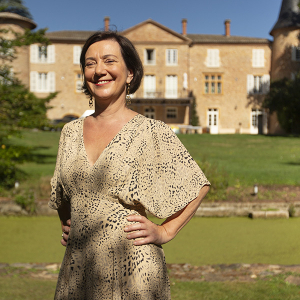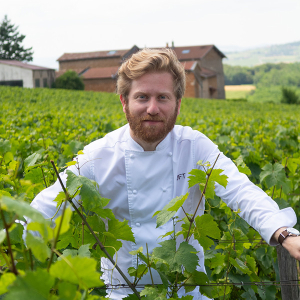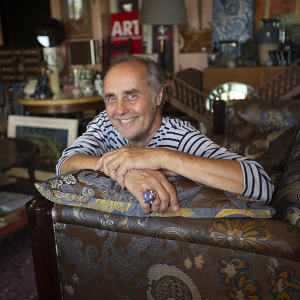Beaujolais is back

The Beaujolais is not only easy to get to, but also packed with great places to eat, endless acres of greenery, and charming traditional villages. The region is pulling out all the stops to attract visitors to explore every last inch of its countryside and vineyards. Report.
By Audrey Grosclaude
Once upon a time, not so long ago, Lyon locals glibly turned up their noses at the Beaujolais, preferring wines from the Bourgogne and the Rhône Valley, and weekends away in the Drôme, Ardèche or Savoie. Everything’s changed.
Firstly, in the vines. With a new generation emerging, climate change hitting, and young winegrowers inspired by the region’s natural DNA setting to work, the vineyards have evolved and developed. To such an extent that the region’s wines, 12 appellations and 10 crus (Saint-Amour, Juliénas, Chénas, Moulin-à-Vent, Fleurie, Chiroubles, Morgon, Régnié, Côte-de-Brouilly, and Brouilly) are back in every wine cellar and the best restaurants worldwide. Of course, the festivities surrounding Beaujolais Nouveau (every 3rd Thursday in November) still play a significant role in promoting the destination globally but now they’re just one of the region’s many attractions along with its forests, châteaux, mountains, golden stone-walled villages, lakes, and the geological heritage of the UNESCO-listed global Geopark.
Surrounded by Burgundy to the north, Lyon to the south, the Loire to the west, and the Ain to the east, the Beaujolais region is popular right now and it shows. “We’re convinced that the Beaujolais has all the ingredients of a top-class tourist destination,” insists Thomas Desmurs, CEO of Destination Beaujolais. The first not inconsiderable advantage for the Beaujolais: how easy it is to get to. No fewer than three regional express train lines go through the leafy Beaujolais Vert and its famous Lac des Sapins, the Beaujolais des Pierres Dorées (i.e., the golden stones), the area around Villefranche-sur-Saône, and the Beaujolais des Crus (i.e., wine country) or Haut-Beaujolais (i.e., upper Beaujolais). This is where most of the vineyards forming the Châteaux en Beaujolais non-profit organisation are focused. This collective created back in 2022 (see three questions to) features ten châteaux remarkable for not only the quality of their wines but also their historical heritage, including Château de Champ-Renard in Blacé.
A land of art and history
A superb Renaissance Revival abode built back in the 13th century, but significantly overhauled over time, Château de Champ-Renard was bought in 2014 by a couple of local Lyon businesspeople, Fabienne Vilain and Denis Garnier. Convinced by the site’s potential, they brought the vineyard back to life and built up a wine tourism business from scratch including hosting events, seminars, tasting workshops, and accommodation: “We fell madly in love with the region and Champ-Renard came to us. It’s an extraordinary area with superb landscapes and magnificent architecture. I’m still surprised when I run into Lyon locals who’ve never visited the Beaujolais but things are changing”, explains Fabienne Vilain. Before her, local Lyon businessman Jean-Claude Lavorel had paved the way back in 2012, buying Château de Bagnols, which was famous for hosting a G7 dinner in 1996 then welcoming holidaying erstwhile Hollywood couple Tom Cruise and Nicole Kidman in 1997. The venue, which has become a 5* hotel & spa, is now one of the jewels of the Lavorel group, which also includes the nearby vineyard at Château des Ravatys in Saint-Lager. In Odenas it’s another Lyon local, businessman Christophe Gruy, who bought Château de La Chaize in 2017 to restore not only the 17th-century building designed by Jules Hardouin-Mansart but also its gardens created by André Le Nôtre to their former glory.
The site is a listed historical monument and now at the centre of an ambitious transformation project aiming to make the vineyard a model of eco-responsibility. Others have followed suite, discovering or rediscovering geological treasures, panoramic hikes (Mont Saint-Rigaud, Mont Brouilly, the terraces of Chiroubles, etc.), the charm of picturesque villages like Oingt, Theizé, Ternand, Clochemerle, and Beaujeu, and the magic of well-preserved natural decors, planted with vines and forests.
"It offers an immediate change 32 of scenery"
Even before the pandemic in 2020, a certain number had decided to move to the southernmost reaches of the Beaujolais, attracted by the region’s transport links, attractive property prices, quality of life and services (health, education, etc.). Between 2015 and 2021, the Communauté de Communes Beaujolais Pierres Dorées (CCBPD, i.e., Beaujolais golden stones federation of municipalities) was the intermunicipal council in the Auvergne-Rhône-Alpes region that attracted the third highest number of new residents.
This dynamism boosts both the local economy and business tourism.
Business heads to the country
“There’s enormous development potential for business tourism in the Beaujolais.
It offers an immediate change of scenery and is very quick to get to by car or train. It’s ideal to get out of Lyon”, explains Céline Paravy-Atlan, founder of MaPièce, a collection of guesthouses for businesses that opened its first venue in the Beaujolais in Lachassagne last March, joining forces with Christian Donzel and Laurent Fiard, manager of Venues for Network and Visiativ: “We organised over forty events over three months with support from a welcoming and very active ecosystem, including the Business Tourism Club, restaurant owners, artisans (Lachassagne bakery, Domaine du Manchot brewery, etc.), and winemakers.” This warm welcome was also hailed by Jean-François Périer-Têtedoie who recently opened the Café Terroir chez Saint-Cyr in Anse. “We arrived with a very humble attitude, listening to people’s expectations and explaining our approach, but when all is said and done it is quite natural for us to set up shop here. The Café Terroir was created with the aim of showcasing the terroir, and that’s exactly what’s happening in the Beaujolais.” Much to the delight of Lyon locals who no longer shy away from enjoying everything the region has to offer.
Diary
Les Vendanges Musicales
Created in 2014, the small Charnay music festival has become an unmissable event. This year’s headliners include Matmatah, Julien Granel, Henriette, Bon Entendeur, Ezza, etc.
19, 20 and 21 September 2024.
lesvendangesmusicales.fr
Festival Nouvelles Voix
The Nouvelles Voix (i.e., new voices) festival, which is dedicated to young songwriters, is celebrating its twentieth anniversary by organising two weeks of concerts across more than ten venues.
From 8 to 19 October 2024.
theatredevillefranche.com
Beaujolais Days
Among the many events organised all across Beaujolais and even in Lyon as part of the Beaujolais Days and Beaujolais Nouveau festivities, don’t miss Les Sarmentelles de Beaujeu: gourmet markets, official ceremony to open the first barrels, tasting sessions, and dancing await you.
From 20 to 24 November 2024.
beaujolaisnouveau.fr
Vente aux enchères des hospices de Beaujeu
On 29 and 30 November, Beaujeu will host the 212th auction organised by its hospices, giving a fresh lease of life to the world’s oldest charity auction! Relaunched by Hôpitaux Nord-Ouest, Burgundy-based winemakers Maison François Martenot, and Vinescence cooperative wine cellar, the event will feature over fifty lots, including different sized bottles and vintages. The profits from the public auction will go to funding the creation of a therapeutic garden. There’ll also be the opportunity to taste wines from the Domaine des Hospices vineyard and to tour the superb apothecary’s store.
maisonfrancoismartenot.com
hno.fr/ventes-hospices-beaujeu
Marathon du Beaujolais
The Beaujolais marathon (France’s biggest fun run) is celebrating its twentieth anniversary on 23 November 2024. It’s an opportunity for the organisers to think big with even more participants (25,000!), plus surprises and activities all along the 42km route, including 15 tasting and 9 refuelling stations. Options: 21km, 13km, 7.5km with Courir pour Elles, and 2.5km for families.
marathondubeaujolais.org
Three questions to Fabienne Vilain
Chair of non-profit organisation "Châteaux en Beaujolais" and owner of Château de Champ-Renard in Blacé.
Châteaux en Beaujolais is a group of over ten châteaux based on the concept of guided tours combining heritage and discovering wine. How did it begin?
The non-profit organisation was created back in 2022 at the behest of Château de Corcelles and Château de La Chaize. Many of us thought that the Beaujolais region’s châteaux weren’t promoted well enough in terms of their winemaking and heritage.
That’s what got us thinking about creating a joint logbook.
Châteaux en Beaujolais’s really distinctive feature is working on wine and heritage at the same time to not only premiumise our wines but also promote the region and its architecture, plus the history and identity of our châteaux, which are all distinct period buildings with different architectures.
Contrary to popular belief, it’s also a new concept…
There are Wine Routes and châteaux in Burgundy but they focus more on the winegrowing side of things. Conversely, history buffs know the châteaux of the Loire well but they have nothing to do with the vineyards. Châteaux en Beaujolais promotes both. We don’t just put on a tour, or a tasting session, but an actual immersive experience of the château with its owner or a member of vineyard staff. Our tours last 1 to 2 hours and provide access to each château’s distinctive features: Château de La Chaize’s vegetable patch and garden, the wine cellars at Château de Juliénas, the indoor rooms at Corcelles or Champ-Renard, costumed dramatized tours at Château de Nervers, etc.
So every vineyard has its own tour format?
Wine tourism was already well established at most of our châteaux but we drew up specifications to guarantee as much consistency as possible for our visitors. For example, all our tours, which can be booked online, are available in either French or English. We’re open on average five days a week (weekends included), and if you pick up a copy of the logbook, you’ll have access to advantages from one château to the next. Our other distinctive feature is accepting and even preferring very small groups. This helps create a close connection and extra-special shared experiences.
Interview by Audrey Grosclaude
chateauxenbeaujolais.fr
Portraits
Caroline Briel, la dolce vita in Villefranche-sur-Saône
Born in Villefranche-sur-Saône, Caroline grew up near Blacé. “My grandparents were winegrowers, I spent my childhood roaming the footpaths and building cabins imagining how I could decorate them. It’s also in the Beaujolais that I took my first photos with my mum’s camera.”
After studying Fine Arts and Applied Arts, Caroline lived in Lyon for ten years. Success came thick and fast there: awards, collaborations with the press and publishers, plus shoots for prestigious brands like Fermob and Petit Bateau, which she staged in her native Beaujolais, creating bucolic, tender and spontaneous decors that still today drive the success of her postcard collections.
She’s a real nature lover and captures the magic of a ray of sunlight, wild grass blowing in the wind, or her children’s smiles on her Instagram account (@cinqmai_shop), gently celebrating everyday moments of grace.
An ode to the joy of simple pleasures to the rhythm of Villefranche-sur-Saône’s seasons.
21 Grande Rue de la Guillotière, Lyon 7th
Jean-François Périer-Têtedoie, 100 % Terroir
“Whether at the Café Terroir or the Café du Peintre, run by my mother and brother, we’ve always worked with the Beaujolais and its winegrowers. Many have become much more than mere clients. This is the case of Raphaël Saint-Cyr who got in touch with us when he was converting the La Galoche grocery store in Anse.”
The Café Terroir chez Saint-Cyr is a real wine-based bistro surrounded by vines that opened in early summer. It features the terroir’s fundamentals: soft-boiled eggs, snails in parsley and garlic sauce from the Monts du Lyonnais, or Bresse chicken served with yellow wine and morel mushrooms, but also suggestions of the day, plus bistronomic dishes created by Chef Maxime Tranier including marrowbone and veal tartare with garlic cream, and sea bass with tomato chutney and caramelised watermelon. Every dish is served with wines from the vineyard or elsewhere: the fine wine list was personally curated by Raphaël Saint-Cyr.
Incredibly friendly atmosphere and bucolic view.
cafeterroir.fr
Jean Boggio, back to school with "Boggio"
We last saw Jean Boggio in Lyon back in 2021 when he was special guest for a carte blanche exhibition at Lyon’s Fabric Museum that was unfortunately disrupted by health restrictions. We met up with him at his home in his beloved “Beaujoland” where he’s lived for the last 30 years, more specifically in the hamlet of Saint-Joseph in Villié-Morgon. For any readers of Michel Houellebecq’s Annihilation, both the location and the artist’s home bear troubling similarities to the novel… But the two men don’t know each other. Even though Jean Boggio - goldsmith, jeweller and antique hunter - has lived a thousand lives, working for Daum, Baccarat, and Les Émaux de Longwy, and commissioned equally often by silk manufacturers as rich collectors who love his phantasmagorical palace rings. In 2023, he and a few friends created the non-profit organisation “Association des Amis de l’École du Beau” with the idea of opening his house (a former 19th-century boarding school) to the public, artistic residences, and tours. In the spirit of the Hôtel d’Agar in Cavaillon. Though the site’s official opening has been postponed until next autumn, feel free to contact him to take a look at the rooms that have already been finished. He easily opens his door...
@jeanboggio




